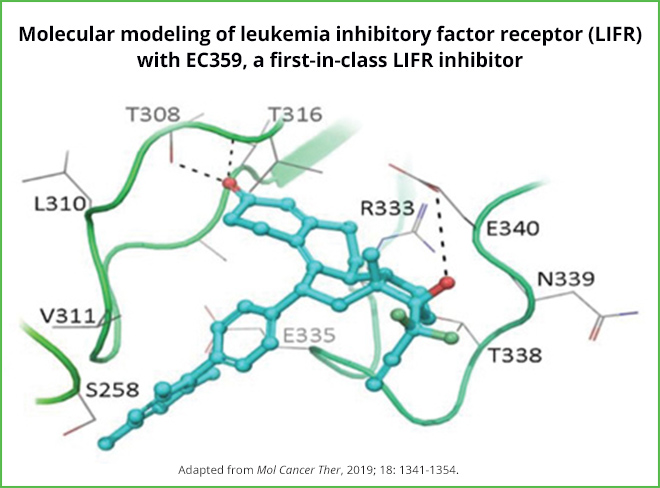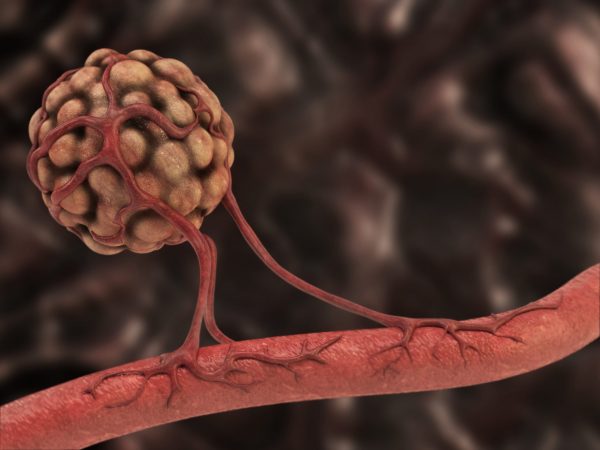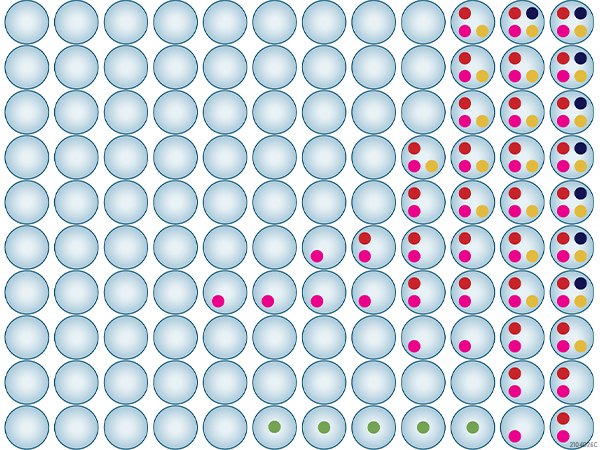August Editors’ Picks from AACR Journals
Back for the final push of summer are the editors’ picks from the eight peer-reviewed scientific journals published by the American Association for Cancer Research (AACR). This August, selections range from the development of a first-in-class inhibitor of the human leukemia inhibitory factor receptor to a global analysis of the increasing incidence of early-onset colorectal cancer. As always, articles highlighted below are freely available for a limited time.
Journal: Cancer Discovery
Cancer-associated fibroblasts (CAFs) are known to play a role in modulating the tumor microenvironment in pancreatic ductal adenocarcinoma (PDAC), but the heterogeneity of this cell population has yet to be fully defined. In this study, the authors analyzed PDAC tumor tissue and adjacent-normal pancreas tissue from human patients and PDAC tumors from mouse models utilizing single-cell RNA sequencing. In addition to myofibroblastic CAFs and inflammatory CAFs, which were identified in their previous studies, the authors describe “antigen-presenting CAFs,” a new population of CAFs that express MHC class II-related genes, which activate CD4+ T cells in an antigen-dependent manner. Future work is needed to identify the intratumoral signals that induce the formation and activation of this CAF subtype, which could be potentially exploited to modulate the immune response in pancreatic tumors.
Journal: Molecular Cancer Therapeutics
The leukemia inhibitory factor (LIF) is a cytokine that activates many cell-proliferation pathways. While the LIF/LIF receptor (LIFR) axis has been shown to promote tumor growth, metastasis, and therapy resistance, no small-molecule inhibitors that block LIF signaling currently exist, representing an untapped therapeutic target. Here, the authors describe EC359, a first-in-class inhibitor of LIFR. Treatment with EC359 inhibited invasion, reduced survival, and induced apoptosis of triple-negative breast cancer (TNBC) cells and reduced tumor progression in TNBC xenografts and patient-derived xenografts. The authors conclude that utilizing this highly potent and specific LIFR inhibitor represents a new mechanism to modulate LIF/LIFR oncogenic functions. A related commentary discussing this article can be found here.
Journal: Cancer Epidemiology, Biomarkers & Prevention
The incidence of young-onset colorectal cancer (CRC) is increasing in the United States, yet whether this trend is present in other parts of the world has not been fully explored. Using data from the International Agency for Research on Cancer from 1988-2007, the authors compared CRC incidence over time between age groups across the globe; data extracted spanned residents from five continents, representing nearly 2 million cases. Compared to those aged 50 years or older, the annual percent change of CRC incidence was found to be increasing in those aged less than 50 years in multiple regions, including Australia, Brazil, Canada, Hong Kong, Shanghai, Japan, the United Kingdom, and the United States. The authors conclude that while young-onset CRC is still relatively uncommon, the increasing incidence of the disease among the young population is an emerging global problem that will have significant ramifications on health care policies in the near future.
Journal: Cancer Immunology Research
Immune-cell infiltration into primary breast tumors can predict pathologic responses to HER2-specific treatment, but obtaining biopsy tissue to study this is not always feasible. The availability of non-invasive diagnostic techniques to analyze circulating immune cells for the prediction of therapeutic response therefore represents an unmet clinical need. In this study, the authors evaluated HER2-positive breast cancer patients treated with HER2-specific therapy and found that the number of natural killer (NK) cells in peripheral blood expressing CD57 before treatment inversely correlated with pathologic complete response. Additionally, the number of circulating CD57+ NK cells inversely correlated with the number of tumor-infiltrating NK cells in breast cancer patients, suggestive of a tumor-homing or proliferative deficiency. The authors conclude that circulating CD57+ NK cells may be a useful biomarker for tailoring HER2 antibody-based therapeutic strategies in breast cancer.
Journal: Cancer Research (August 1 issue)
Modeling Gliomas Using Two Recombinases
Tumor induction via the Cre/loxP recombination system has been widely utilized to study animal models of malignant gliomas, but a limitation of this system is the lack of ability to further genetically manipulate an induced tumor to explore the progression of tumorigenesis. In this study, the authors describe the development of a new transgenic mouse model, glial fibrillary acidic protein (GFAP)-FLP recombinase (FLPo) mice, which express FLPo recombinase exclusively in cells that are positive for GFAP in the brain. Using an FLP-inducible lentiviral system, the authors induced gliomas in the GFAP-FLPo mice. By combining a Cre-mediated multifluorescent protein-expressing system, the researchers could analyze multiple stages of gliomagenesis in these mice. The authors posit that this new model will expand the ability to dissect developmental processes of gliomagenesis.
Journal: Clinical Cancer Research (August 15 issue)
Alterations to the fibroblast growth factor receptor (FGFR) have been implicated in carcinogenesis and in acquired treatment resistance. This study reports on the final safety and efficacy results from a phase I clinical trial evaluating erdafitinib, a pan FGFR inhibitor, in 187 patients with advanced or refractory solid tumors for which standard antineoplastic therapy was no longer effective. Among evaluable patients that harbored mutations or fusions in the FGFR gene, those with urothelial carcinoma or cholangiocarcinoma had objective response rates of 46.2 percent and 27.3 percent, respectively. The objective response rates in other tumor types with altered FGFR was less than 10 percent, and the most common treatment-related adverse events across all patients were hyperphosphatemia (64 percent), dry mouth (42 percent), and asthenia (28 percent). Based on these results, further studies evaluating erdafitinib in patients with urothelial carcinoma or cholangiocarcinoma harboring FGFR alterations are warranted.
Journal: Cancer Research (August 15 issue)
Recycling Endosomes in Mature Epithelia Restrain Tumorigenic Signaling
The evolutionarily conserved, small GTPase Rab11 is an endosome recycling protein that maintains intestinal epithelial integrity and polarity, but its role in cellular growth and long-term gut homeostasis remains understudied. Here, the authors demonstrate that Rab11 deficiency resulted in intestinal epithelial dysplasia in early animal development and synergized with oncogenic pathways to accelerate tumorigenesis induced by carcinogen, genetic mutation, or aging. Additionally, analysis of Rab11-deficient intestines in mice and drosophila revealed activation of members of the Hippo pathway Yki/Yap, the suppression of which lead to reduced dysplastic and hyperplastic growth. The authors conclude that recycling endosome proteins in mature epithelia constitute an important class of tumor suppressors.
Journal: Molecular Cancer Research
T-Cell Deletion of MyD88 Connects IL17 and IκBζ to RAS Oncogenesis
The adapter protein MyD88, whose downstream effectors include the NF-κB complex, has been implicated in cancer pathogenesis. To explore its role in murine Ras-mediated squamous cell carcinoma of the skin, the researchers studied the skin of MyD88-deficient mice and found a reduction in T cells producing the cytokine IL17 compared with controls. In both normal and RAS-transformed keratinocytes, the introduction of IL17 increased IκBζ expression, and genetic ablation of IκBζ in keratinocytes reduced Ras-mediated papilloma formation in mice. The authors conclude that IL17 signaling through IκBζ helps to establish a tumor-permissive environment in the skin, and warrants further study as a potential therapeutic target.
Journal: Cancer Prevention Research
Because patients with inflammatory bowel disease (IBD) colitis have an increased risk of developing colorectal cancer, several guidelines recommend extensive colonoscopy surveillance with multiple random biopsies repeated as frequently as every year. However, most of these surveillance colonoscopies are negative and no objective measures for assessing cancer risk in these individuals currently exists, representing an urgent need for an alternative risk-surveillance approach. The authors previously developed a method to detect colonic neoplasia via three-dimensional nanoscale nuclear architecture mapping (nanoNAM) on normal-appearing rectal biopsies and sought to establish its translational relevance in this study. Both standard-of-care surveillance biopsies and pinch biopsies from normal-appearing rectal mucosa were collected during initial and follow-up colonoscopies from 103 patients with IBD colitis; compared with the conventional pathology analysis of normal-appearing rectal mucosa, nanoNAM could better stratify patients with low- and high-risk of developing cancer. These results provide further evidence that nanoNAM can be utilized to detect colonic neoplasia and assess cancer risk from histologically normal-appearing cells from the easily accessible rectum, which can be obtained in a less invasive manner than colonoscopy.
Journal: Clinical Cancer Research (August 1 issue)
A prior clinical trial conducted by the study authors revealed that patients who received vitamin D following an allogenic stem cell transplant had lower incidence of chronic Graft versus Host Disease (GvHD); the current study evaluated if common polymorphisms of the vitamin D receptor (VDR) had an impact on the immunomodulatory effect of vitamin D in this setting. Among patients with the FokI CT VDR genotype, those who received vitamin D following allogenic stem cell transplantation had a significantly decreased incidence of overall chronic GvHD compared with those that did not receive vitamin D (22.5 percent versus 80 percent, respectively). Among patients treated with vitamin D, those with the FokI CT VDR genotype had a 70 percent reduction in the risk of chronic GvHD compared with those with the FokI CC VDR genotype. The authors conclude that polymorphisms to the VDR, especially the FokI CT genotype, can affect the immunomodulatory role of vitamin D following allogenic stem cell transplantation.




